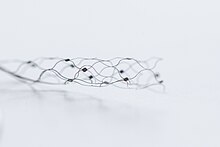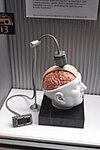Stent-electrode recording array

Stentrode (Stent-electrode recording array) is a small stent-mounted electrode array permanently implanted into a blood vessel in the brain, without the need for open brain surgery. It is in clinical trials as a brain–computer interface (BCI) for people with paralyzed or missing limbs,[1] who will use their neural signals or thoughts to control external devices, which currently include computer operating systems. The device may ultimately be used to control powered exoskeletons, robotic prosthesis, computers or other devices.[2]
The device was conceived by Australian neurologist Thomas Oxley and built by Australian biomedical engineer Nicholas Opie, who have been developing the medical implant since 2010, using sheep for testing. Human trials started in August 2019[3] with participants who suffer from amyotrophic lateral sclerosis, a type of motor neuron disease.[1][4] Graeme Felstead was the first person to receive the implant.[5] To date, eight patients have been implanted and are able to wirelessly control an operating system to text, email, shop and bank using direct thought through the Stentrode brain computer interface, marking the first time a brain-computer interface was implanted via the patient's blood vessels, eliminating the need for open brain surgery.
The FDA granted breakthrough designation to the device in August 2020.[6] In January 2023, researchers demonstrated that it can record brain activity from a nearby blood vessel and be used to operate a computer with no serious adverse events during the first year in all four patients.[7][8]
Overview
Opie began designing the implant in 2010, through Synchron, a company he founded with Oxley and cardiologist Rahul Sharma.[9] The small implant is an electrode array made of platinum electrodes embedded within a nitinol endovascular stent. The device measures about 5 cm long and a maximum of 8 mm in diameter.[10] The implant is capable of two-way communication, meaning it can both sense thoughts and stimulate movement, essentially acting as a feedback loop within the brain, which offers potential applications for helping people with spinal cord injuries and control robotic prosthetic limbs with their thoughts.[11][12][13]
The Stentrode device, developed by Opie and a team at the Vascular Bionics Laboratory within the Department of Medicine at the University of Melbourne,[14] is implanted via the jugular vein into a blood vessel next to cortical tissue near to the motor cortex and sensory cortex, so open brain surgery is avoided.[15] Insertion via the blood vessel avoids direct penetration and damage of the brain tissue. As for blood clotting concerns, Oxley says neurologists routinely use permanent stents in patients' brains to keep blood vessels open.[15] Once in place, it expands to press the electrodes against the vessel wall close to the brain where it can record neural information and deliver currents directly to targeted areas.[10] The signals are captured and sent to a wireless antenna unit implanted in the chest, which sends them to an external receiver. The patient would need to learn how to control a computer operating system that interacts with assistive technologies.
The Stentrode technology has been tested on sheep and humans, with human trials being approved by the St Vincent's Hospital, Melbourne Human Research Ethics Committee, Australia in November 2018.[16][4] Oxley originally expressed that he expected human clinical trials to help paralyzed people regain movement to operate a motorized wheelchair or even a powered exoskeleton.[10] However, he switched focus before beginning clinical trials. Opie and colleagues began evaluating the Stentrode for its ability to restore functional independence in patients with paralysis, by enabling them to engage in activities of daily living.[17] Clinical study results demonstrated the capability of two ALS patients, surgically fitted with a Stentrode, to learn to control texting and typing, through direct thought and the assistance of eye-tracking technology for cursor navigation.[18] They achieved this with at least 92% accuracy within 3 months of use, and continued to maintain that ability up to 9 months (as of November 2020).[18] This study helped to dispel some criticism that data rates may not be as high as systems requiring open brain surgery, and also pointed out the benefits of using well-established neuro-interventional techniques which do not require any automated assistance, dedicated surgical space or expensive machinery.[citation needed]
Selected patients are people with paralyzed or missing limbs, including people who have suffered strokes, spinal cord injuries, ALS, muscular dystrophy, and amputations.[15][10]
See also
References
- ^ a b "Brain implant allows mind control of computers in first human trials". New Atlas. 5 November 2020. Retrieved 8 November 2020.
- ^ "Minimally Invasive "Stentrode" Shows Potential as Neural Interface for Brain". DARPA. 2016-02-08. Retrieved 9 February 2016.
- ^ "Stentrode with Thought-controlled Digital Switch: An Early Feasibility Study (EFS) of the Safety of the Stentrode Device in Participants with Loss of Motor Function Due to Paralysis". 29 August 2022.
- ^ a b Oxley, TJ; Yoo, PE (2020). "Motor neuroprosthesis implanted with neurointerventional surgery improves capacity for activities of daily living tasks in severe paralysis: first in human experience" (PDF). Journal of NeuroInterventional Surgery. 13 (2): neurintsurg-2020-016862. doi:10.1136/neurintsurg-2020-016862. PMC 7848062. PMID 33115813.
- ^ "Patients with Severe Paralysis Use Stentrode Brain-Computer Interface to Text, Email, Shop, Bank Online, First-in-human Study Reports – Neurosurgical.TV". 28 October 2020.
- ^ "Stentrode brain-computer interface receives breakthrough device designation from FDA". Neuro News. BIBA Medical. 28 August 2020. Retrieved 18 January 2021.
- ^ Lanese, Nicoletta (12 January 2023). "New 'thought-controlled' device reads brain activity through the jugular". livescience.com. Archived from the original on 16 February 2023. Retrieved 16 February 2023.
- ^ Mitchell, Peter; Lee, Sarah C. M.; Yoo, Peter E.; Morokoff, Andrew; Sharma, Rahul P.; Williams, Daryl L.; MacIsaac, Christopher; Howard, Mark E.; Irving, Lou; Vrljic, Ivan; Williams, Cameron; Bush, Steven; Balabanski, Anna H.; Drummond, Katharine J.; Desmond, Patricia; Weber, Douglas; Denison, Timothy; Mathers, Susan; O’Brien, Terence J.; Mocco, J.; Grayden, David B.; Liebeskind, David S.; Opie, Nicholas L.; Oxley, Thomas J.; Campbell, Bruce C. V. (9 January 2023). "Assessment of Safety of a Fully Implanted Endovascular Brain-Computer Interface for Severe Paralysis in 4 Patients: The Stentrode With Thought-Controlled Digital Switch (SWITCH) Study". JAMA Neurology. 80 (3): 270–278. doi:10.1001/jamaneurol.2022.4847. ISSN 2168-6149. PMC 9857731. PMID 36622685. S2CID 255545643.
- ^ "Synchron - Company Profile - Tracxn". 2 January 2024.
- ^ a b c d Stimulating the brain – without major surgery. Catriona May, The University of Melbourne. Published by Pursuit. 4 December 2018.
- ^ Focal stimulation of the sheep motor cortex with a chronically implanted minimally invasive electrode array mounted on an endovascular stent. Nicholas L. Opie, Sam E. John, Gil S. Rind, Stephen M. Ronayne, Yan T. Wong, Giulia Gerboni, Peter E. Yoo, Timothy J. H. Lovell, Theodore C. M. Scordas, Stefan L. Wilson, Anthony Dornom, Thomas Vale, Terence J. O'Brien, David B. Grayden, Clive N. May, and Thomas J. Oxley. Nature - Biomedical Engineering, Vol. 2, 3 December 2018, pp: 907–914 doi:10.1038/s41551-018-0321-z
- ^ New device to get people with paralysis back on their feet. University of Melbourne. 8 February 2016.
- ^ Implant Stimulates Brain From Inside a Blood Vessel. Megan Scudellari.
- ^ "Brain-Computer Interfaces Evolve to Help People With Paralysis". interestingengineering.com. 2021-10-19. Retrieved 2021-10-24.
- ^ a b c Strickland, Eliza (2017-04-12). "5 Neuroscience Experts Weigh in on Elon Musk's Mysterious "Neural Lace" Company". IEEE Spectrum. Retrieved 2021-09-08.
- ^ A digital spinal cord that streams your thoughts. Thomas Oxley, TEDxSydney.
- ^ Articles·, FeaturedNeurologyNeuroscienceNeuroscience VideosNeurotechOpen Neuroscience (2020-10-28). "Small Brain Device Proves Big Game Changer for Severely Paralyzed Patients". Neuroscience News. Retrieved 2021-10-24.
- ^ a b Oxley, Thomas J.; et al. (2021). "Motor neuroprosthesis implanted with neurointerventional surgery improves capacity for activities of daily living tasks in severe paralysis: first in-human experience". Journal of NeuroInterventional Surgery. 13 (2). Society of Neurointerventional Surgery: 102–108. doi:10.1136/neurintsurg-2020-016862. PMC 7848062. PMID 33115813. Retrieved 18 January 2021.
- v
- t
- e

 Category
Category Commons
Commons














